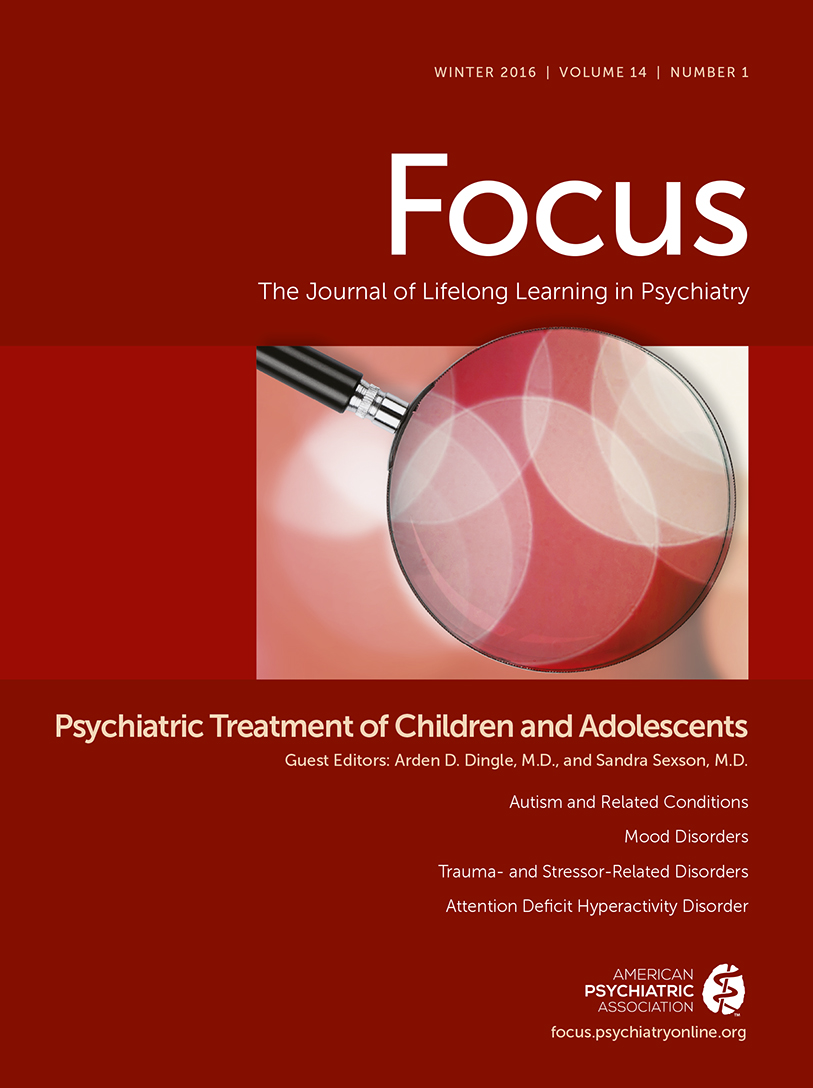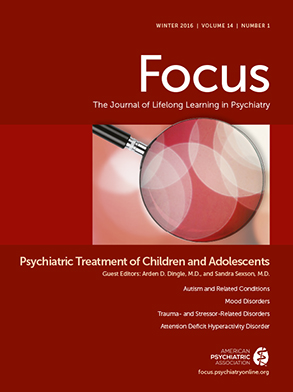This exercise is designed to test your comprehension of material relevant to this issue of Focus as well as your ability to evaluate, diagnose, and manage clinical problems. Answer the questions below, to the best of your ability, with the information provided, making your decisions as you would with a real-life patient.
Questions are presented at “consideration points” that follow a section that gives information about the case. One or more choices may be correct for each question; make your choices on the basis of your clinical knowledge and the history provided. Read all of the options for each question before making any selections. You are given points on a graded scale for the best possible answer(s), and points are deducted for answers that would result in a poor outcome or delay your arriving at the right answer. Answers that have little or no impact receive zero points. At the end of the exercise, you will add up your points to obtain a total score.
Case Vignette
William “Billy” Case is a 16-year-old Caucasian male who presents to you with his father to address problems related to high school. Billy is somewhat tall and thin. He is wearing tattered jeans and a T-shirt. His hair is poorly shorn, with streaks of purple. He has multiple earrings and a nose ring. Billy’s father reports that Billy has significant truancy, poor grades, and episodes of oppositional-defiant behavior both at home and at school. The father also reports that Billy is almost pervasively irritable and appears in a constant state of fatigue, complaining about his life and future being pitiful and hopeless.
Initially, Billy says little and does not see what the problem is—he just does not like school. His father relates a long history of behavior problems, including impulsivity and oppositional and aggressive behavior starting in preschool. At one point, sometime in early elementary school, Billy’s pediatrician prescribed methylphenidate (Ritalin). However, soon after, Billy’s parents divorced due to his father’s drinking. Billy lived with his mother in a distant state until recently, when his mother sent Billy to live with his father. The father believes that the mother met with a family therapist several years ago due to problems similar to those presenting today. According to the father, Billy has been “very difficult” since he moved to live with him. The father admits difficulty managing Billy and providing any limits, stating “I cannot keep track of where he is or who he is with.” Attempts to provide structure have been met with hostility and arguing, with Billy ignoring his father or stating that he “forgot” to do what he had promised him.
During your interview with Billy alone, he reluctantly describes that is he frequently irritable with intense but limited periods of depressed mood (less than a day) and frequent angry outbursts, which may include threats of harming himself (or others) or punching holes in household walls. He admits to intermittent periods of hopelessness and suicidal ideation. He states that he could get a gun if he really wanted to. Billy denies sleep disturbance. He states that he has never done well in school, never does homework, and believes he used to be “hyper” in elementary school. He has been fired from several part-time jobs as a result of being chronically late or making “silly” mistakes. He initially admits to “some” marijuana use, having tried a variety of other drugs but rejecting alcohol unless he is really high. Billy is fidgety in his chair and seemingly distractible. His affect is quite labile. Billy’s mood is likewise reported as rapidly changing from angry to irritable to depressed with periods of euthymia as well. His thought processes are linear and goal directed. Cognitive functions are intact and within normal limits. Additional history includes Billy’s eventual admission that he will usually go to school high, skip classes to use drugs, or miss entire school days. On a search of his school locker, a pipe was discovered, resulting in a suspension. The case is being referred to a local magistrate, with a hearing date pending. When Billy is not using drugs, he admits to thinking about getting high “a lot.”
Consideration Point A
At this point in the assessment of the patient’s history, your differential diagnosis includes the following:
A.1
___Attention-deficit hyperactivity disorder (ADHD)
A.2
___Major depressive disorder
A.4
___Posttraumatic stress disorder
A.5
___Disruptive mood dysregulation disorder
Vignette Continues
Billy acknowledges that his friends are also often in trouble with drugs and with the law. You screen him for drug and alcohol use, and Billy reluctantly reports daily use of cannabis. He started using marijuana at age 11 with other middle school friends who were likewise doing poorly in school and were often in trouble. He does not care how he is doing in school, and he plans to drop out next year and get his GED. Most of his time outside of school involves using cannabis or obtaining marijuana. He has lost two jobs because he was late to work as a result of using marijuana. Even at times when he planned to stay sober or to smoke “just a bit” for some occasion, he admits to using much more than he had planned—often through an entire evening and into the early morning hours. One of his former girlfriends thought he used “way too much” and wanted him to quit. He has tried to cut down, unsuccessfully, and even quit several times, but eventually lost his relationship with his girlfriend and felt even more hopeless and worthless. Several times during the interview, Billy emphatically declares that he is not interested in stopping his marijuana use, although the idea of possibly “cutting down” intrigues him.
Consideration Point B
At this point, the following therapeutic strategy is recommended for the patient:
B.2
___Referral to Narcotics Anonymous
B.3
___Motivational interviewing
B.5
___Cognitive-behavioral therapy for drug use
Vignette Continues
Given Billy’s ambivalence, you begin to utilize motivational interviewing in hopes of moving Billy toward a more active interest in initiating treatment and curtailing his marijuana use. When asked if there were any problems that bothered him, Billy again acknowledges periods of dysphoria, hopelessness, and low self-esteem. Although he continues to express little desire to stop marijuana use, he seems to soften when he begins to connect much of the dysphoric mood to his cannabis use and resulting consequences. Using this motivation for entering active treatment, you and Billy develop a change plan that includes the use of cognitive-behavioral therapy for drug abuse. Together, you identify triggers for use. For Billy, these triggers included his dysphoric mood states, association with friends, and general frustration when his daily plans go awry. Billy is thus able to develop strategies for dealing with or even avoiding the triggers. In addition, Billy is able to formulate a list of prosocial activities and peers to replace those that he needed to avoid or give up in order to avoid drug-related triggers that might provoke his return to marijuana use. Although not explicitly part of his change plan, Billy begins to avoid similar triggers for marijuana use, and his use of this substance begins to decline. Billy’s mood shows overall improvement, with the cessation of severe dysphoric episodes. Although he is not entirely abstinent concerning substance use, he begins to attend school. However, his academic progress remains poor because he finds studying or completing homework to be difficult. In addition, he intermittently makes foolish, impulsive decisions. Many of these decisions place him in problem situations such as being suspended in school or rejected by peers.
Consideration Point C
Given all of the details of the case, your next therapeutic step or steps are as follows:
C.1
___Start a psychostimulant for the treatment of ADHD to decrease Billy’s impulsivity
C.2
___Refer the patient to Narcotics Anonymous
C.3
___Start an atypical antipsychotic agent to target mood dysregulation
C.4
___Establish a strict schedule of regular urine drug screens to test for drugs of abuse
C.5
___Start a selective serotonin reuptake inhibitor to target dysphoric mood episodes
Vignette Concludes
In cooperation with Billy’s father, you prescribe Billy a sustained-release psychostimulant. Billy’s father gives him a daily dose in the morning and keeps track of the prescription. You continue to monitor Billy’s drug use, both soliciting self-reports from him but also using random urine drug screens. With his father, you arrange a program of contingency management, providing set rewards for negative screen results. Billy’s school performance improves, and he finds that he is no longer getting into trouble because of impulsive comments and poor decisions. Billy finds a more prosocial peer group in which there is little drug or alcohol use. He is better able to avoid triggers for marijuana use and demonstrates several months of abstinence. He feels he is better able to proceed with and master other elements of his change plan.
Answers: Scoring, Relative Weights, and Comments
Consideration Point A
A.1
___
(+2) Attention-deficit hyperactivity disorder (ADHD). Both current symptoms and past history strongly suggest an ADHD diagnosis, which is often prevalent in populations of adolescents with substance use disorders (
1).
A.2
___(+1) Major depressive disorder. There are some mood symptoms, but they may not be persistent enough to meet full criteria.
A.3
___(+3) Cannabis use disorder. Regular use and DSM-5 symptoms are present (e.g., a great deal of time spent in activities related to use, recurrent use resulting in failure to fulfill role obligations [school], and craving) and point to a diagnosis of cannabis use disorder.
A.4
___(0) Posttraumatic stress disorder. There is no evidence of a significant trauma.
A.5
___
(+3) Disruptive mood dysregulation disorder. The history of ADHD plus pervasive irritability and angry outbursts strongly support a diagnosis of disruptive mood dysregulation disorder. Each of these characteristics places youths at high risk for substance use and the development of a substance use disorder (
2).
Consideration Point B
B.1
___
(+3) Family therapy. Several types of family therapy, including multidimensional family therapy and functional family therapy, have strong support for being efficacious for substance use disorders (
3).
B.2
___
(+1) Referral to Narcotics Anonymous. Although there is very little available evidence via randomized controlled trials, Narcotics Anonymous may be a reasonable adjunct to more proven therapies for adolescents (
4).
B.3
___
(+2) Motivational interviewing. Emerging evidence suggests that motivational interviewing is a good adjunct to other therapies (
5).
B.4
___(+1) Drug court. The patient has an upcoming hearing, but evidence of effectiveness is still modest.
B.5
___
(+3) Cognitive-behavioral therapy for drug use. Cognitive-behavioral therapy, in both group and individual formats, has strong evidence as an effective therapy (
3).
Consideration Point C
C.1
___
(+2) Start a psychostimulant for the treatment of ADHD to decrease Billy’s impulsivity. Although there is minimal support for psychostimulant treatment resulting in improvement in drug use, there is modest support for ADHD symptom improvement. Stimulant therapy should be avoided when abuse involves stimulant agents (
6).
C.2
___(+2) Refer the patient to Narcotics Anonymous. Although there is very little evidence available via randomized controlled trials, Narcotics Anonymous may be a reasonable adjunct to more proven therapies for adolescents.
C.3
___(0) Start an atypical antipsychotic agent to target mood dysregulation. Although there is emerging evidence to support the use of atypical antipsychotic agents for severe mood dysregulation (or disruptive mood dysregulation disorder), in this case, Billy’s mood has begun to improve with largely psychosocial interventions. The decreasing level of mood symptoms does not justify the risks involved with these agents.
C.4
___
(+3) Establish a program of random urine drug screens to test for drugs of abuse. Urine toxicology is a standard procedure in treatment of substance use disorders and is best used as part of a therapy program for these disorders that has rewards and consequences based on the outcome of the test (e.g., contingency management) (
7).
C.5
___(0) Start a selective serotonin reuptake inhibitor to target dysphoric mood episodes. Billy’s mood has begun to improve with largely psychosocial interventions.


